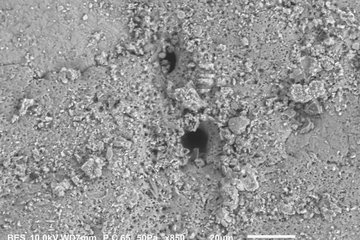Palaeoproteomics helps differentiate between modern humans and Neandertals
Researchers decode ancient proteins of Châtelperronian Neandertals
The Châtelperronian of central France and northern Spain is critical to the debate regarding Neandertal cognition, their use of artefacts typically associated with modern humans and finally, their extinction. Despite intense research, the exact biological nature of the Châtelperronian people is still disputed and no direct molecular data for a Neandertal association with the Châtelperronian has been obtained. To solve this problem, an international research team utilized recent developments in ancient protein analysis, combined with multiple additional lines of evidence to demonstrate that the Châtelperronian hominins at the Grotte du Renne, an archaeological site from north central France, are Neandertals.

Using peptide mass fingerprinting for rapid, low-cost detection of hominin remains, the team has been able to identify 28 additional hominin specimens among previously unidentifiable bone fragments from the Châtelperronian layers of the site. They combine palaeoproteomic and palaeogenetic methods to demonstrate the Neandertal ancestry of these fragments, which most likely represent the remains of a single, immature, breastfed individual. The direct radiocarbon date obtained for this individual is fully consistent with its direct association to the Châtelperronian assemblage at the site.
For the first time, the paper demonstrates the ability of palaeoproteomics to discriminate between Late Pleistocene clades within the human genus based on protein amino acid sequences alone. “To differentiate between modern humans, Neandertals and Denisovans on the basis of ancient protein research provides really exciting opportunities for future research into the origins of our and their evolutionary history”, says lead author Frido Welker of the Max Planck Institute for Evolutionary Anthropology and the University of York. “These ancient hominin proteins in Pleistocene bones hold valuable phylogenetic and physiological information.”
Bones derive from Neandertal infant
For example, the researchers were able to provide independent morphological, isotopic and proteomic lines of evidence that suggest that the analyzed bone specimens derive from a breastfeeding infant. “To identify proteins related to specific developmental stages of bone formation highlights one of the main strengths of ancient protein research, especially in a multi-disciplinary context”, says Matthew Collins of the University of York. Ph.D. student Frido Welker adds “The dynamic nature of the bone proteome has a lot to offer when studying the physiology and ontogeny of Pleistocene mammals, including hominins.”

By providing a direct radiocarbon date for one of the hominin specimens, the authors argue that these hominin specimens can be attributed to the advanced Châtelperronian artefacts found at this and other Châtelperronian archaeological sites. This confirms that Neandertals were responsible for some artefact types previously argued by some to be exclusively in the realm of modern human cognitive abilities.
Jean-Jacques Hublin, director of the Department of Human Evolution at the Max Planck Institute for Evolutionary Anthropology, explains “The process of replacement of archaic local populations by modern humans in Eurasia is still poorly understood as the makers of many palaeolithic tool-kits of this time period remain unknown. This type of research allows us to extract unrecognisable human fragments out of large archaeological assemblages and to revisit the mode and the tempo of this major event in human evolution with fresh material“.
FW/HR













